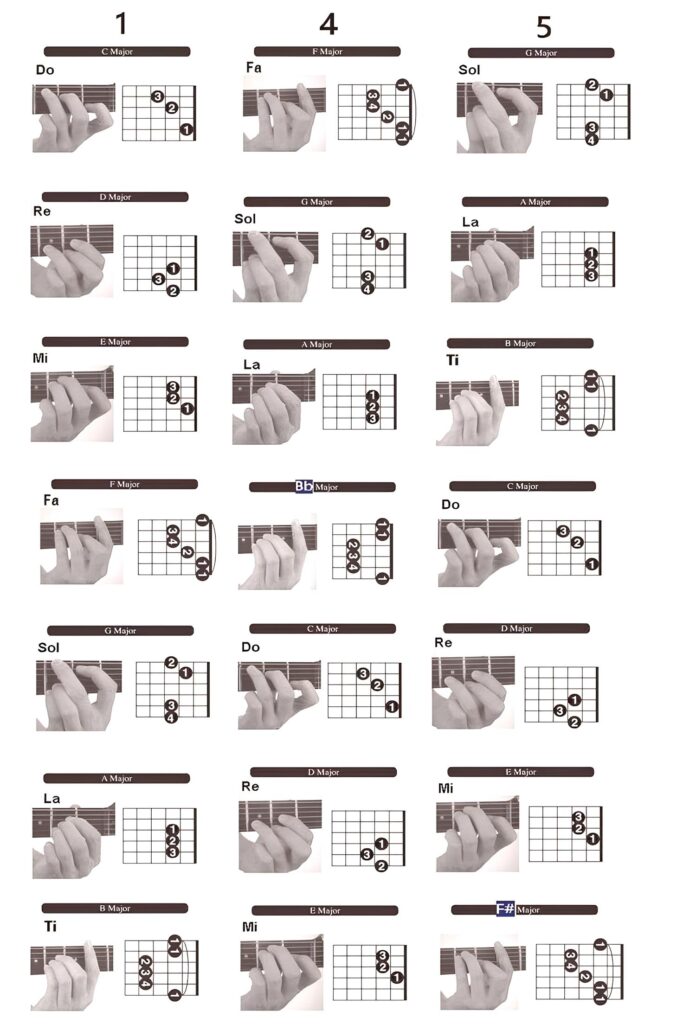The warm tones of the acoustic guitar have captivated hearts for generations. But the path to mastery can seem daunting for beginners. Fear not, aspiring musicians! This guide will break down your journey into manageable steps, equipping you with the knowledge and tools to achieve your musical goals.
Stage 1: Building the Foundation (Weeks 1-4)
- Get the Gear: Begin with a good quality acoustic guitar, tuner, picks, and (optionally) a metronome. Consider your budget and playing style.
- Posture & Hand Position: Develop proper posture and finger placement for optimal comfort and playing efficiency. Numerous online resources can guide you.
- Conquering Chords: Start with fundamental open chords like G, C, D, and E. Use chord diagrams from online resources, apps, or beginner guitar books.
- Unlocking Rhythm: Master basic strumming patterns like down-up, down-down-up, and down-up-down-up-down. Practice transitioning smoothly between chords while strumming.


Stage 2: Expanding Your Horizons (Weeks 5-8)
- Beyond Open Chords: Explore barre chords to unlock diverse melodies and progressions. Practice transitioning smoothly between open and barre chords.
- Strumming Adventures: Introduce variations to your strumming, experimenting with accents, muted strums, and different picking patterns.
- Fingerpicking Fundamentals: Learn basic fingerpicking patterns to create richer, melodic textures.
- Meet the Fretboard: Understand the notes on the fretboard and practice scales to improve dexterity and musical understanding.
Stage 3: Deepening Your Skills (Weeks 9-12)
- Genre Exploration: Delve into genres you enjoy, learning specific chords, techniques, and songs associated with that style.
- Advanced Techniques: Explore techniques like bends, hammer-ons, pull-offs, and fingerstyle playing to add depth and expression to your music.
- Improvisation: Start improvising simple melodies over chord progressions, gradually building your improvisational vocabulary.
- Ear Training: Train your ear to recognize intervals, melodies, and chords by ear. Online resources and apps can help you develop this crucial skill.
Stage 4: Refining Your Mastery (Beyond Week 12)
- Challenge Yourself: Set ambitious goals, pushing yourself to learn complex chords, intricate fingerpicking patterns, and challenging solos.
- Analyze the Greats: Study the playing styles of your favorite guitarists, deconstructing their techniques and incorporating elements into your own playing.
- Performance & Feedback: Share your music with others! Perform at open mic nights, jam sessions, or with friends. Use their feedback to identify areas for improvement.
- Continuous Learning: Embrace the lifelong journey of learning. Explore music theory, learn new genres, and constantly challenge yourself to grow as a guitarist.
Remember:
- Practice Regularly: Consistent practice is key to progress. Short, focused sessions are more effective than long, sporadic ones.
- Find the Fun: Choose songs and styles you enjoy to keep yourself motivated. Learning should be an exciting adventure!
- Seek Guidance: Consider online lessons, apps, or private teachers for personalized instruction and feedback.
- Celebrate Milestones: Acknowledge your achievements, big and small, to stay motivated on your journey.
Here are some things you can do to learn acoustic guitar:
Get the right gear:
- Guitar: Choose a good quality beginner acoustic guitar. Consider your budget, size, and playing style.
- Picks: Experiment with different pick thicknesses to find one that feels comfortable.
- Tuner: A clip-on tuner is essential for keeping your guitar in tune.
- Metronome: Helps develop your sense of rhythm and timing.
- Capo (optional): Makes playing songs in different keys easier.
Build a foundation:
- Learn proper posture and hand position: This helps prevent injuries and ensures efficient playing.
- Practice basic chords: Start with major chords like G, C, D, and E. Use online resources, apps, or guitar books to learn chord diagrams.
- Learn basic strumming patterns: Down-up, down-down-up, and down-up-down-up-down are popular starting points.
- Practice switching chords: Gradually increase the speed and accuracy of your transitions.
- Learn how to read tablature (optional): This notation system shows where to place your fingers on the fretboard.
Find learning resources:
- Online lessons: Many free and paid online resources offer video lessons, interactive exercises, and chord libraries.
- Apps: Consider apps like Yousician, Fender Play, or Simply Guitar for structured learning and feedback.
- Guitar books: Mel Bay’s Complete Guitar Method and Justin Guitar’s Beginner Course are popular options.
- Private lessons: A guitar teacher can provide personalized guidance and feedback, which can be especially helpful for beginners.
Practice regularly:
- Set achievable goals and practice daily, even if it’s just for 15 minutes. Consistency is key to progress.
- Focus on having fun! Play songs you enjoy to stay motivated.
- Challenge yourself gradually: As you progress, learn new chords, techniques, and songs.
- Record yourself playing: Listen back to identify areas for improvement.
- Connect with other guitarists: Join online communities or find a local jam session to share your learning journey and get feedback.
Additional resources:
- Justin Guitar: https://www.justinguitar.com/
- Fender Play: https://www.fender.com/play
- Yousician: https://yousician.com/
- Marty Music: https://m.youtube.com/watch?v=EHu2SjmYjck
- The D-C-G Trick: What Famous Bands Did With Easy Chords!
- Mastering the E Power Chord on Electric Guitar: A Beginner’s Guide with Chord Chart Examples
- Unlocking “I Can See You”: Taylor Swift’s Vault Unleashes a Chunky Pop Anthem
- Paint the Town Red with Doja Cat: Your Easy Guitar Chord Lesson
- Simple Chord Progression in the key of C Major using the Em, C, G, and D Chords
- A Comprehensive PDF Guide for Beginners – Guitar Chord Book + 296 Songs

